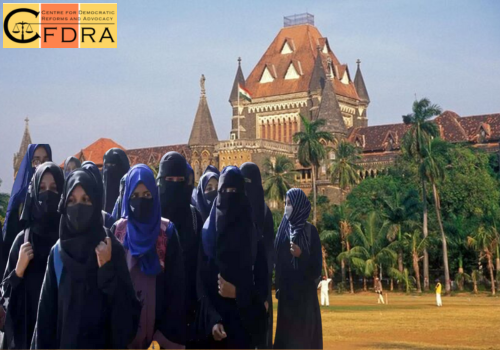Bombay High Court Upholds College Ban on Hijab and Other Religious Attire: A Detailed Analysis

Background and Legal Battle
The Bombay High Court recently made headlines by dismissing a plea filed by nine female students challenging the dress code enforced by NG Acharya and DK Marathe College in Mumbai. The contentious dress code prohibits students from wearing items like hijab, naqab, burka, stoles, caps, and badges on campus premises. The court’s decision came amidst arguments centered on fundamental rights, religious freedom, and educational policy.
Petitioners’ Argument and Legal Standing
The petitioners, students in their second and third years pursuing science degrees, argued that the college’s directive infringed upon their fundamental rights guaranteed under the Constitution of India. They contended that the ban on religious attire such as hijab and naqab violated their rights to privacy, dignity, religious freedom, and choice. Advocate Altaf Khan, representing the petitioners, emphasized the cultural and religious significance of wearing the hijab in Islam, citing the Quranic verses to support their stance.
College’s Defense and Policy Rationale
In contrast, the college management defended its stance, asserting that the dress code was implemented to maintain a uniform dress standard across all students, irrespective of religious affiliations. Senior advocate Anil Anturkar, representing the college, clarified that the prohibition on religious symbols was intended to prevent the open display of such symbols, except where explicitly mandated by the fundamental right to religion, such as the Sikh turban. He argued that the policy applied uniformly to all students, regardless of their religious background.
Judicial Review and Bombay High Court’s Decision
The division bench of Justice AS Chandurkar and Justice Rajesh Patil, while delivering the verdict, expressed reluctance to intervene in the college’s internal disciplinary measures. The judges underscored the importance of upholding educational institutions’ autonomy in implementing reasonable regulations concerning student conduct and appearance. They highlighted that the imposition of a dress code, including restrictions on religious attire, fell within the purview of the college’s administrative discretion, provided it did not violate fundamental rights.
Comparative Legal Perspectives
Advocate Altaf Khan drew parallels with a recent Karnataka High Court judgment on a similar issue, where the court ruled against a government order banning the hijab in junior colleges. Khan argued that unlike Karnataka, where the ban was imposed on a pre-existing uniform policy, the Mumbai college’s directive was arbitrary and lacked legal sanction. He contended that the sudden enforcement of the dress code via WhatsApp without statutory backing infringed upon the petitioners’ constitutional rights.
Public Discourse and Community Impact
The case has sparked significant public discourse on the intersection of religious freedom and educational policies in India. Supporters of the petitioners argue that the ban disproportionately affects Muslim students and restricts their access to education. They cite constitutional provisions safeguarding minority rights and religious freedom as pivotal in challenging such restrictions. On the other hand, proponents of the college’s stance maintain that uniformity in dress promotes equality and unity among students from diverse backgrounds.
Constitutional and Human Rights Considerations
The legal debate surrounding the case delves into constitutional provisions such as Articles 19 (freedom of speech and expression) and 21 (right to life and personal liberty), which encompass the right to privacy and personal autonomy. Critics of the ban argue that it violates these fundamental rights by dictating personal choices related to attire, thereby impinging on individual freedoms guaranteed under the Constitution.
Policy Implications and Educational Governance
The broader implications of the Bombay High Court’s decision extend to educational governance and policy-making in India. It raises questions about the extent of institutional autonomy versus individual liberties within educational settings. The verdict prompts reflection on the balance between fostering a conducive learning environment and respecting cultural and religious diversity among students.
Future Legal Course and Potential Ramifications
Looking ahead, the outcome of this case may influence future legal challenges and policies concerning dress codes and religious practices in educational institutions across India. It underscores the need for nuanced judicial interpretation and legislative clarity on issues pertaining to religious freedoms and educational rights. The legal fraternity awaits the detailed judgment copy from the Bombay High Court, which will provide insights into the reasoning behind the dismissal of the petition and its implications for similar cases in the future.
Conclusion
In conclusion, the Bombay High Court’s dismissal of the plea challenging the college’s dress code marks a significant chapter in the ongoing discourse on religious freedoms and educational governance in India. The case underscores the delicate balance between institutional regulations and individual rights, shaping the contours of legal precedents and public policy in the country. As the debate continues, stakeholders advocate for inclusive educational environments that respect diversity while upholding constitutional values of equality and liberty.


